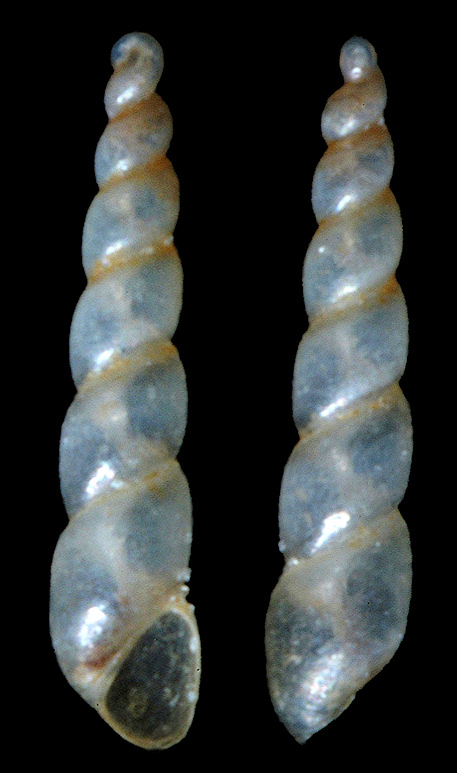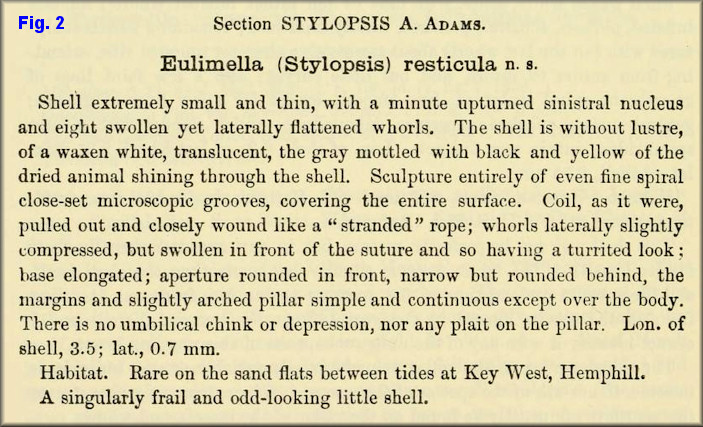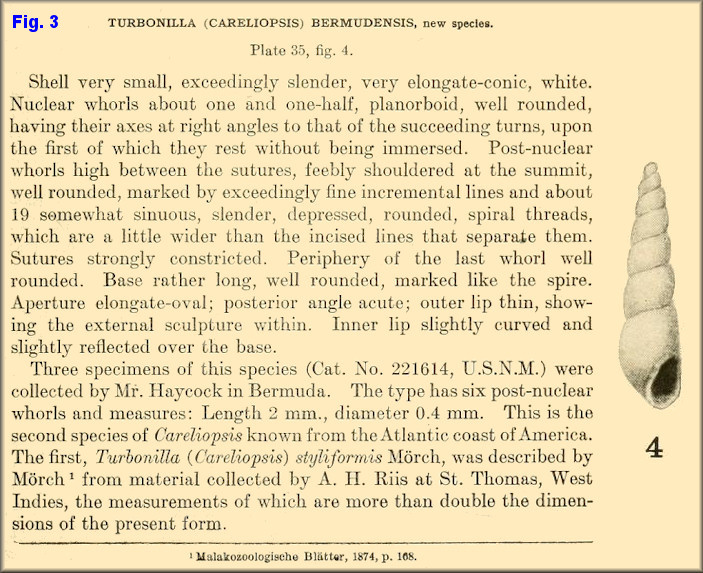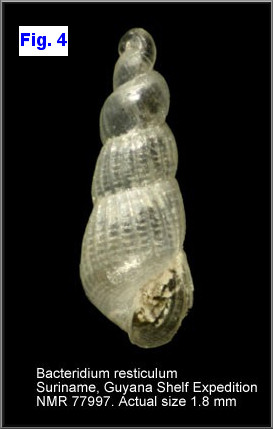|
Ebala species [read on] |
|
|
|
|
|
Beach drift, Billy's Bay, St. Elizabeth Parish, Jamaica (1.9 mm) . Digital images by David Kirsh. |
|
Review of the ORIGINAL descriptions and
available authentic figures illustrations (see
Figs 1-3) of the
three species indicated above reveals very similar heteroaxial
hyperstrophic protoconchs but shells otherwise distinguishable from
the specimen figured above, which was collected by David. The fossil
taxon Turbonilla (Stylopsis) octona (Fig. 1) is
a smooth shell with rather similar oblique sutures, but the broader
initial whorls differ significantly. Both Eulimella (Stylopsis) resticula and Turbonilla (Careliopsis) bermudensis of
Dall and Bartsch, 1911 (Figs. 2 and 3 respectively) have a less
attenuated profile, less oblique sutures, and a distinct spiral
sculpture. These three and David Kirsh's shell above, which seems to
have been misattributed to each of them in the literature, belong in
the either the murchisonellid/ebaline genus Ebala Gray, 1847
[Type species (TS)
Turbo nitidissimus
Montagu, 1803 by original
monotypy (OM)] or the pyramidellid genus Bacteridium Thiele,
1929 [TS Eulimella praeclara Thiele, 1925 OM]* rather than
the pyramidellid genera Careliopsis
[e.g., <http://www.jaxshells.org/1002xx.htm>], Eulimella, Stylopsis, or
Turbonilla to which they'd been variously assigned over the
years.
* These two genera, Ebala and Bacteridium, while not
very closely related phylogenetically have "astonishingly similar
shells" and can only be distinguished by the presence of a bizarre
"jaw apparatus" characteristic of the murchisonellids (Warén, 1994).
That's not all: while the Brazilian workers found no spiral
sculpture on the holotypes of these two taxa, they did on the
holotype of Turbonilla (Stylopsis) octona Guppy in
Guppy in Dall, 1897 and synonymized it with Eulimella (Stylopsis)
resticula Dall, 1889 refuting two or the three original
descriptions above. All the preceding observations demonstrate the
folly of total reliance of original descriptions (and figures) in
proper taxonomy!
A shell image (reproduced below as
Fig. 4)
putatively (and incorrectly) captioned Bacteridium resticulum
as treated by the World Register
of Marine Species (WoRMS <http://www.marinespecies.org/aphia.php?p=taxdetails&id=420472>)
appears to belong in a separate genus,
perhaps Falsoebala Gründel, 1998 [see
Falsoebala
species Fossil]
and is probably undescribed.
Pimenta, A.D. and R.S. Absalão, 2001. The
genera Bacteridium Thiele, 1929 and Careliopsis Mörch,
1875 (Gastropoda: Pyramidellidae) from the east coast of South
America. Bollettino Malacologico 37(1-4): 41-48. Warén, A., 1994 Systematic position and validity of Ebala Gray, 1847 (Ebalidae fam. n., Pyramidelloidea, Heterobranchia. Bollettino Malacologico 30(5-9): 203-210. 30 Nov. <https://biodiversitylibrary.org/page/49937818> |
|
|
|
|
|
|
|
|

![Stylopsis] octona](images%20snail9/123uu.jpg)


